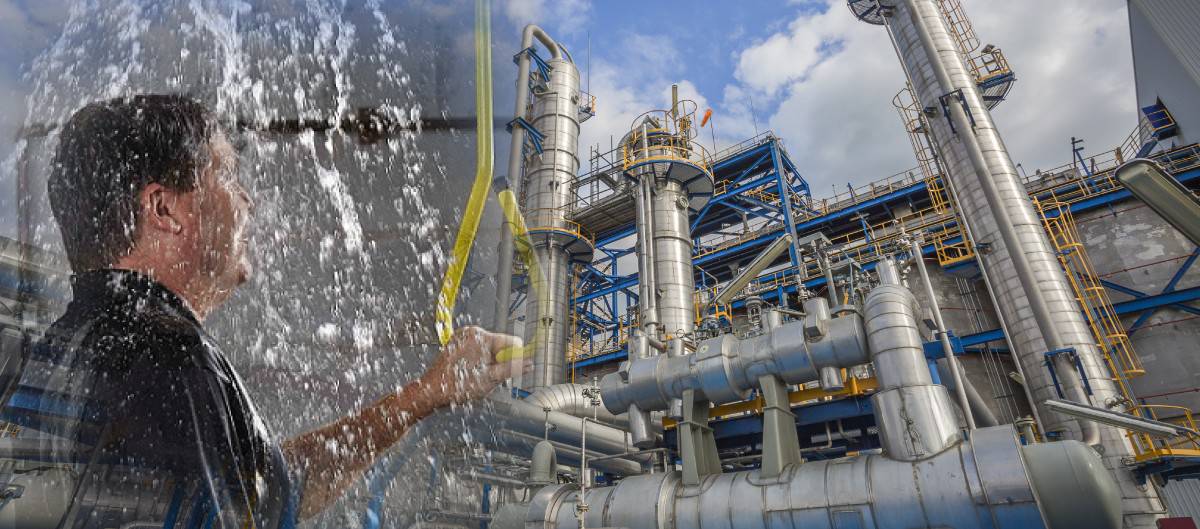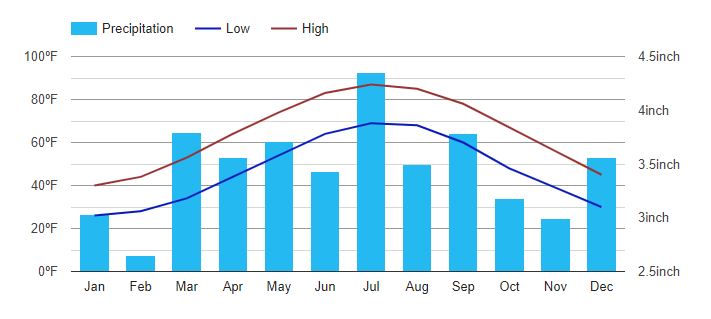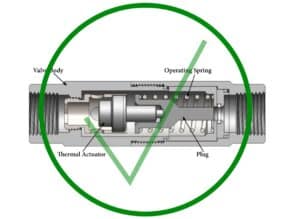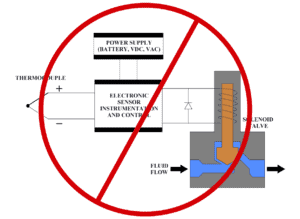7 Benefits of Thermostatic Control
When it comes to system performance in mission-critical aerospace and defense applications, thermal control is a leading factor in successful operation. Having an effective flow control device to balance temperature within the system ensures a more efficient and stress-reduced operation.
There are two commonly implemented types of flow control valves for A&D applications, solenoid valves and thermostatic valves.
Solenoid valves require a complex set-up with multiple components external to the valve, as well as a source of DC power to operate which tends to increase installation expenses, space requirements, and the risk of operation failure in the case of a power outage or component failure.
ThermOmegaTech recommends thermostatic valves as the #1 thermally controlled flow solution for A&D applications. Precise, compact, and reliable, thermostatic valves are entirely self-powered and respond to narrow temperature variations to precisely control system flow, without the need for an external power source.
7 Benefits of Thermostatic Valves
Thermostatic control valves can be used for heating or cooling to effectively control temperature in various applications. Simplistically designed with paraffin wax actuator technology, these temperature control valves are versatile with a number of advantages that solenoid valves simply can not beat.
- Self-actuating
- Highly-repeatable
- Long service life
- Maintenance-free
- few moving parts
- Compact
- Unaffected by extremes – ideal for hazardous environments
To learn more about the difference in these types of valves check out our comparison sheet.
Safety Shower & Eyewash Station ANSI Recommendations

Does your facility comply with industry standard safety recommendations for emergency safety shower and face/eyewash stations?
Any industrial facility that handles hazardous chemicals, debris, or other corrosive material must take the necessary precautions to ensure the safety of their employees. Installing a face/eyewash station that meets the appropriate flow requirements recommended by the ANSI is the first step to a safe working environment.
ANSI Z358.1-2014 Standard Flow & Temperature Recommendations:
- Flow requirement for safety showers min. of 20 GPM at 30 PSI
- Flow requirement for eyewash min. of 0.4 GPM at 30 PSI
- Flow requirement for safety shower/eyewash station combination min. of 3.0 GPM at 30 PSI
- Temperature requirement for all emergency station outputs uninterrupted tepid water (60-100°F [16-38°C]) flow for at least 15 minutes.
Failing to meet these flow and temperature recommendations can result in serious long-term damage to the users eyes, skin, limbs or other body parts due to scalding or insufficient removal of hazardous material.
To ensure an emergency fixture is able to meet the minimum-flow requirements as detailed by ANSI’s Z358.1-2014 standard, it’s important to consider plumbing line size, water quality and the tepid water delivery system being used. Click here to see what ANSI z358.1-2014 recommends.
Therm-O-Mix® Tepid Water Delivery System
Using a facilities existing steam and water supply, ThermOmegaTech®’s Therm-O-Mix® Station instantaneously delivers tepid water for safety showers and eyewash stations, while conforming to OSHA and ANSI recommendations for both flow and water temperature. Learn More.
Watch Your Climate: Protect Your Locomotive Fleet

Winter is well upon us, and it’s here to stay. While most operators complete their winterization procedures well ahead of freezing temperatures, for those experiencing freeze-ups or in need of a few extra Gurus to keep their fleet running, we invite you to visit our Locomotive Freeze Protection and Passenger Car Freeze Protection page to learn about our reliable & self-actuating railroad freeze protection products.
If you are wondering when to expect warmer weather to thaw out your corner of the country and banish the dangers of freezing temperatures, use the national climate checker tool below.

Click here and trace the blue line to learn when temperatures will drop below freezing, and when you can expect daisies to start blooming. For railroad protection, the temperature at which your locomotives and passenger trains will freeze is at 32°F, and these temperatures can last well into March in some regions.
Looking to Upgrade Your Freeze Protection?
Fit out your fleet with ThermOmegaTech’s locomotive and passenger car freeze protection drain valves. These valves are proven to perform, even in the most brisk winter weather. Trusted by all the Class 1s and major North American railroad operators, you can rest assured that your trains will be protected and on time all winter long.
Steam Valves: Improve Your Winterization Process & Your Savings
Steam tracing emptying your wallet each winter? It may be because you are using a manually controlled steam tracing system.
While manually controlled steam tracing is an effective method to eliminate the chance of freeze damage, these systems can have two common risks:
- Forgetting to turn the system on due to human error – resulting in freeze damage
- Not turning them off during non-freezing periods – wasting steam when unnecessary and ballooning costs
To significantly reduce steam costs over the freeze season, ThermOmegaTech recommends using a thermostatically controlled steam tracing solution. In these systems, steam is controlled by a thermostatic valve that continuously monitors temperatures, turning steam supply on only when the temperature falls towards freezing, and automatically turning it off to conserve supplies on warmer days.
Thermostatic steam valves eliminate the risks associated with human error, while ensuring the heating media is effectively used, resulting in a significant cost savings over a single freeze season.

What Your Facility Could Be Saving
A winterizing steam tracing system in a plant located in Philadelphia, PA consumes about 500 lbs. per hour of steam. This system was manually turned on in the beginning of the freeze season (mid-September) and was not turned off until the dangers of freezing temperatures passed (mid-April). Total operating hours are an estimated 5,088:
Cost of Manual Operation
When using a manually controlled system where steam is constantly on from September to April:
500 lbs. per hour x 5,088 hours x $8.00/thousand lbs. = $20,352.00 per winter season.
Cost of Thermostatic Operation
When using thermostatic control valves that turn off steam when temperature rises above 45°F:
500 lbs. per hour x 2,895 hours x $8.00/thousand lbs. = $11,580.00
per winter season.
*Based on U.S. Weather Bureau data for Philadelphia, steam will be on for only 2,895 hours each winter.
ESTIMATED SAVINGS = $8,772.00 per year
Click here to see the full report.
Are You Due For a GURU Rebuild?
Cold weather is quickly approaching, and most locomotive operators have already begun their annual winter prep. In anticipation of freezing temperatures, we recommend evaluating your currently installed GURU Plugs and rebuilding those that have been in service for more than 18-24 months via the GURU Rebuild Program
Why Rebuild Your GURU Plugs?
As your GURU ages, there is an inherent tendency for its internal thermal actuator to lose a small amount of stroke. While this would never compromise your freeze protection, this tendency results in an upwards release temperature creed, which can cause nuisance dumping above the valve’s set-point.
To prevent this upward creep in nuisance dumping, ThermOmegaTech offers the GURU Rebuild Program, an easy and economical way to restore used GURU plugs to full functionality.

How It Works
To participate in the Rebuild Program, used GURU Plugs must first be returned to our production facility with a purchase order. We then disassemble the valve, clean the cartridge body and hex nut, and replace its interior components. After reassembly, the refurbished GURU Plug is thoroughly tested to ensure full functionality before being returned to the field.
How To Know You Are Due For A Rebuild
Each GURU’s Plug has a yearly-rotated color cap which is also laser marked with its month and year of manufacture.

If it has been at least 18-24 months since a valve’s manufacture date, you should consider a rebuild.








